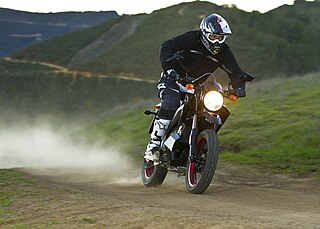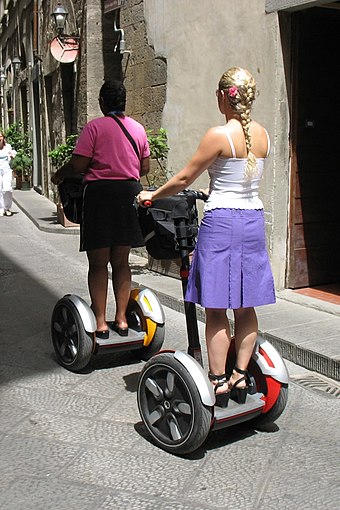
An electric unicycle is a self-balancing personal transporter with a single wheel. The rider controls the speed by leaning forwards or backwards, and steers by twisting the unit using their feet. The self-balancing mechanism uses gyroscopes, accelerometers in a similar way to that used by the Segway PT.

A gyrocar is a two-wheeled automobile. The difference between a bicycle or motorcycle and a gyrocar is that in a bike, dynamic balance is provided by the rider, and in some cases by the geometry and mass distribution of the bike itself, and the gyroscopic effects from the wheels. Steering a motorcycle is done by precessing the front wheel. In a gyrocar, balance was provided by one or more gyroscopes, and in one example, connected to two pendulums by a rack and pinion.

Lithium batteries are primary batteries that have lithium as an anode. These types of batteries are also referred to as lithium-metal batteries.

A timeline of United States inventions encompasses the ingenuity and innovative advancements of the United States within a historical context, dating from the Contemporary era to the present day, which have been achieved by inventors who are either native-born or naturalized citizens of the United States. Patent protection secures a person's right to his or her first-to-invent claim of the original invention in question, highlighted in Article I, Section 8, Clause 8 of the United States Constitution which gives the following enumerated power to the United States Congress:

Vectrix was an electric vehicle company based in Middletown, Rhode Island, United States, with research and development facilities in New Bedford, Massachusetts and an assembly plant in Wrocław, Poland. Vectrix ceased all US operations as of December 31, 2013. The company filed for bankruptcy and final liquidation in March 2014.

Electric motorcycles and scooters are plug-in electric vehicles with two or three wheels. The electricity is stored on board in a rechargeable battery, which drives one or more electric motors. Electric scooters have a step-through frame.

A dicycle is a vehicle with two parallel wheels, side by side, unlike single-track vehicles such as motorcycles and bicycles, which have inline wheels. Originally used to refer to devices with large wheels and pedals, the term is now used in relation to powered self-balancing scooters with smaller wheels and no pedals such as the Segway PT and the self-balancing hoverboard.

Trevor Blackwell is a computer programmer, engineer and entrepreneur based in Silicon Valley.

Valence Technology, Inc. develops and manufactures lithium iron phosphate cathode material as well as lithium ion battery modules and packs. The modules come in 12 V, 18 V, 24 V, and 36 V configurations. Valence's products are used in electric vehicle and plug-in hybrid electric vehicles (PHEVs) such as cars, scooters, motorbikes, and commercial vehicles such as buses, delivery vans and trucks. Valence batteries are also used in wheelchairs, medical carts, robotics, marine, rail, as well as stationary applications such as remote power, uninterruptible power supply (UPS), energy storage systems, frequency regulation and switching gear.

The Uno is a novel self-balancing electric motorcycle using two wheels side by side. The Uno III adds third wheel that allows it to transform into a tricycle.

The Personal Urban Mobility and Accessibility (PUMA) was an experimental electrically powered road vehicle created by Segway and adopted by General Motors as a concept vehicle representing the future of urban transportation. It operates on two wheels placed side by side, a layout that differs in placement from motorcycles which instead have their two wheels placed at the front and rear.

The Honda U3-X is an experimental self-balancing one-wheeled personal transporter shown in 2009.
Lit Motors Inc. is a San Francisco-based company that designed conceptual two-wheeled vehicles, including a fully electric, gyroscopically stabilized vehicle.
Robstep is a line of two-wheeled, self-balancing, battery-powered electric vehicles invented by Dongguan Robstep Robot Co., Ltd. of Guangdong, Dongguan, China. The name "Robstep" is a portmanteau of the words "robot" and "step", meaning robotic steps. The devices have been compared to Segways.

The Honda UNI-CUB is a concept 2-axis self-balancing personal transporter for use in barrier-free indoor environments, and shown at the Osaka Motor Show 2013.

A self-balancing scooter is a self-balancing personal transporter consisting of two motorized wheels connected to a pair of articulated pads on which the rider places their feet. The rider controls the speed by leaning forwards or backwards, and direction of travel by twisting the pads.
The following is a list of Xiaomi Smart Home Products. They are products released by third-party manufacturers who have partnered with Xiaomi.






















